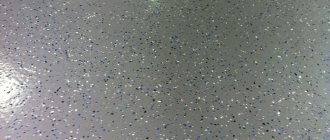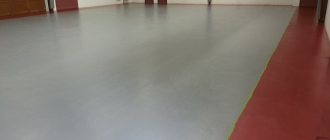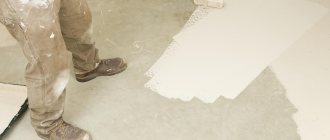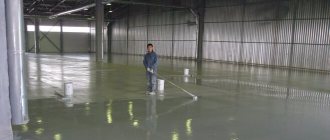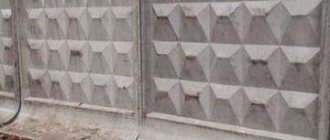Epoxy paints for concrete AKVAPROTEK (EP-2347)
EP-2347
Two-component epoxy waterproof paint for the protection of concrete and metal substrates indoors.…
570 rub. per kg.
Epoxy paints for concrete EPOSTREAM (EP-2345)
EP-2345
Two-component epoxy paint for concrete and metal. High curing speed. Increased durability...
525 rub. per kg.
Epoxy paints for concrete EPOSTREAM-2 (EP-2346)
EP-2346
Two-component epoxy paint for the protection of concrete and metal substrates indoors. Tinted...
550 rub. per kg.
Polyurethane paints for concrete POLISTREIN-2 (PU-2357)
PU-2357
Two-component polyurethane paint for protecting concrete and metal substrates indoors.…
395 rub. per kg.
Polyurethane paints for concrete POLYSTREIN (PU-2356)
PU-2356
One-component polyurethane paint designed to protect concrete and metal substrates inside…
395 rub. per kg.
Polymer primers for concrete floors
Epoxy primer for concrete EPOXICOR AS EP-0305
EP-0305
Conductive epoxy primer for conductive polymer floors. Two-component epoxy primer...
705 per 1 kg.
Epoxy primers for concrete EPOXICOR (EP-0303)
EP-0303
Two-component, colorless, low-viscosity epoxy primer, contains organic solvent
610 per 1 kg.
Epoxy primer for concrete EPOXICOR-100 (EP-0302)
EP-0302
High quality epoxy two-component primer. For parking lots, class A warehouses, industrial…
790 per 1 kg.
Epoxy primers for concrete EP-0301-White
EP-0301-White
Two-component epoxy primer, white, low-viscosity, contains organic solvent
600 per 1 kg.
Epoxy primer for concrete EPOXYTOP (EP-0301)
EP-0301
Two-component, based on a polyamine hardener, used as a primer for dust removal…
600 per 1 kg.
Polyurethane primers for concrete PU-0314
PU-0314
Two-component universal polyurethane primer for installing polymer self-leveling floors inside…
415 per 1 kg.
Polyurethane primers for concrete POLIUKOR AS (PU-0312)
PU-0312
Conductive polyurethane primer for antistatic systems
470 per 1 kg.
Polyurethane primers for concrete POLYDIP (PU-0311)
PU-0311
A one-component, moisture-curing, deep-penetration polyurethane primer. Contains...
360 per 1 kg.
Polyurethane primers for concrete POLIUKOR (PU-0310)
PU-0310
One-component, colorless, low-viscosity polyurethane primer, air-curable. Contains...
370 per 1 kg.
Polymer paints for concrete industrial floors are paints and varnishes for effective protection. They are applied to the base in a thin layer. The special composition can withstand all types of loads.
There may be doubts that ordinary paint applied in a thin layer is capable of protecting the surface. But for industrial floors, special compounds are used.
They can easily withstand mechanical and static loads, exposure to chemicals and temperature changes. They do not fade in the sun and retain an attractive appearance for a long time. Also suitable for indoor walls, wood and metal.
Turnkey painting cost per m2
Dust removal - 0.2 mm.
- Materials and costs: 0303 -0.4 kg/m2.
- Price of materials price: 156 rub./m2.
- Material price from: 140 rub./m2
- Main types of work: sanding, priming 2 layers.
- Work prices: from 100 rubles/m2.
- Price of material + work: from 240 rub.
Painting with epoxy paints 1 - 0.4 mm
- Materials and costs: EP-0303-0.4 kg/m2; EP-2346-04 kg./m2.
- Price list of materials: 156+160=316 rub./m2.
- Material price from: 284 rub./m2.
- Main types of work: sanding, priming 2 layers, painting 2 layers.
- Work prices: from 250 RUR/m2.
- Price of materials + work: from 534 rubles.
Painting with epoxy paints 2 - 0.4 mm
- Materials and costs: EP-0302-0.25 kg/m2; EP-2346-04 kg./m2.
- Price list of materials: 123.75+160=283.75 rub./m2.
- Material price from: 254 rub./m2.
- Main types of work: sanding, priming 2 layers, painting 2 layers.
- Work prices: from 250 RUR/m2.
- Price of materials + work: from 504 rub.
Painting with polyurethane paints - 0.4 mm
- Materials and costs: PU-0310-04 kg./m2; PU-2356-04 kg./m2.
- Price of materials: 124+146=270 rub./m2.
- Material price from: 243 rub./m2.
- Main types of work: sanding, priming 2 layers, painting 2 layers.
- Work prices: from 250 RUR/m2.
- Price materials + work: from 493 rub.
The minimum cost per square meter with material is indicated. To calculate the cost of a self-leveling floor, the price per m2 of which depends on the area of pouring, please contact our manager by phone
How to choose the right material
When buying paint, you should consider several factors:
Purpose of the material
Here you need to consider whether the paint will be applied outside or inside. In addition, it is necessary to keep in mind the surface properties, material and temperature, and other operating conditions of the coating;
Insulated surface area
Since paint consumption is much greater than that of conventional paints and varnishes, it is necessary to take into account the thickness of the layer and the degree of viscosity of the material;
Color shade
If for internal insulation of office premises this point is not so important, then for facades or open surfaces a more careful approach is required.
By comparing these criteria and considering the characteristics of the material indicated on the packaging, the optimal option is selected. It is not recommended to act at random - if in doubt, you should contact a sales consultant and explain your tasks to him. A specialist will help you make the right choice.
Problems of concrete industrial floor
Concrete is usually used for the installation of industrial floors. This material can withstand a lot of weight. This allows it to be used in workshops with heavy equipment.
The second advantage of a concrete floor is its affordable price. It makes this type of industrial floor the most popular.
However, concrete industrial floors have a number of significant disadvantages. When subjected to mechanical stress, it quickly wears off. This process is accompanied by the formation of dust, which is harmful to the health of workers and equipment.
Many people consider concrete to be monolithic, but this opinion is wrong. The structure of this material is porous. Water penetrates into these microscopic voids. When the temperature drops to sub-zero, the liquid freezes and destroys the seemingly durable surface.
Chemical compounds are absorbed into the pores of concrete. For example, fuels and lubricants. They leave unsightly stains on the floor. When applying another type of floor covering, these areas must be thoroughly cleaned.
Under difficult operating conditions, which is typical for industrial premises, the concrete surface becomes covered with cracks and potholes. This makes further use of the floor impossible.
Selection rules
First of all, you should decide on the place where the thermal paint will be applied. Usually, the jar with the product is labeled by the manufacturer. Look carefully at what surface this product can be applied to.
Carefully inspect the contents of the jar. It should be uniform, there should be no plaque or any inclusions. It is desirable that the color be white, but light shades of gray or beige are allowed. Otherwise, the product will not meet the declared qualities.
The density of the product should not be ignored. A low indicator of this criterion will give greater heat transfer. In addition, you should familiarize yourself with the service life and interaction with external environmental indicators. For example, ultraviolet light, fire or water.
Not all liquid thermal insulation has an easy application method. Make sure that the product not only meets the required protection and density parameters, but is also convenient to use.
Since there are a large number of manufacturers of this insulation on the market, it is better to give preference to a time-tested brand. This way you can be sure of the quality and reliability of the purchased product.
What does painting a concrete industrial floor provide?
To protect industrial floors from destruction, special paints and varnishes are used. These are not ordinary enamels, but special mixtures that, after drying, form durable coatings.
Wear-resistant paint for concrete industrial floors penetrates into the porous structure of the substrate. After hardening, it reliably binds together the smallest particles inside the building material.
On the surface, paint and varnish compositions form a protective film with high performance in many respects:
- strength;
- wear resistance;
- moisture resistance;
- resistance to aggressive chemicals;
- neutral attitude towards temperature changes;
- durability.
Painted industrial floors have a perfectly smooth surface without joints. It is easy to care for because it does not absorb moisture and does not react with household chemicals.
After hardening, paints for industrial floors acquire a decorative appearance. This significantly expands the scope of their application. Painted floors look elegant not only in production workshops, but also in public buildings with high traffic.
Manufacturers
There are various brands of thermal insulation paints on sale.
Among them, the following materials have the most favorable ratio of quality and cost:
"Corundum"
This is a group of compounds designed to work in different conditions. Basically, they are designed for insulation of pipelines with hot water or coolant, although the operating temperature range is from -60 ° C to +250 ° C;
"Astratek"
This is a dispersed paint, without organic solvents. It is safe and convenient for treating hot surfaces or communications;
"Armor"
Paint with ceramic granules with anti-condensation properties. Withstands contact with solar ultraviolet radiation well, which allows the material to be used on open surfaces or structures;
"Akterm-Standard"
Heat-resistant paint that can withstand temperatures up to 600 °C. It is used both for refrigeration equipment and for painting hot pipelines (helps maintain temperature during transportation of coolants or process fluids).
There are other brands that are of fairly high quality. Among them are materials such as “Alfatek”, “Keramoizol”, “Teplokor”, “Magniterm”, “Gidrostop pro”, etc. It is completely pointless to list them, since in any case you will have to choose according to your own criteria.
Prices for paint for concrete industrial floors
The cost of paints and varnishes for industrial floors is higher than the price of conventional enamel. But this is justified by high performance characteristics.
If ordinary paint for interior work, for example, water-based acrylic or alkyd urethane, will increase the moisture resistance of the concrete base for a short period, then special paints and varnishes will last up to 7–8 years under intense loads.
The use of primer compositions with similar characteristics will help reduce paint costs. These mixtures clog the pores and reduce paint consumption, since it is not absorbed into the base, but lies in an even thin layer on its surface.
An additional bonus is increased wear resistance of the floor covering. You won't have to renew your painted floor as often. This is a better prospect than the almost annual repair of an unpainted base.
Useful tips from professionals
When preparing the floor for coating with enamel or paint, it is necessary to wash it with warm soapy water. After cleaning, wait until the surface dries.
Quartz sand is often added to the primer.
This will make the coating less slippery.
It is necessary to carefully prime the surface using special compounds. This will help prevent dust from appearing. You can start painting only after the primer has dried. To check if the floor is ready, touch the surface. If it is not sticky, you can start applying the coating.
Types of paints for concrete industrial floors
Polymer and acrylic paints are used to paint industrial floors. Only they have high-quality characteristics that allow them to withstand high operating loads.
It should be noted that polymer paints and varnishes are more resistant and durable. While acrylic paints are recommended only for moderate loads.
PolyTek System LLC produces paints for concrete industrial floors in Moscow. The company's products are valued for their high quality on the building materials market in Russia.
In addition to manufacturing, you can order painting of industrial floors in any volume from the manufacturer. Qualified specialists will perform the work at a high professional level and guarantee the final result.
Polymer enamels for concrete industrial floors are available in two types:
- polyurethane;
- epoxy.
Both types have high strength and wear resistance, but they also have significant differences. The scope of application of paints and varnishes depends on them.
Polyurethane paints for industrial floors
The most popular type of polymer paint and varnish compositions is polyurethane paints. What distinguishes them is
- high strength;
- wear resistance;
- moisture resistance;
- resistance to shock and vibration;
- neutral attitude to temperature fluctuations;
- inertness to aggressive chemical compounds;
- durability.
Polyurethane paints and varnishes can be used in the most difficult conditions. Heavy equipment can be moved around the production floors. Vibrating machines are allowed to be installed indoors.
If heavy objects fall onto the floor during the production process, the coating will maintain its integrity.
Dirt, dust, fuels and lubricants do not leave marks on the polyurethane coating. You just need to wipe it down to return it to hygienic cleanliness. Acids and alkalis do not corrode the protective layer and do not spoil its appearance.
Polyurethane compositions come in two types: one-component and two-component. The former are used for thin-layer (less than 1 mm) application. The latter are recommended for self-leveling floors.
After hardening, two-component compositions have maximum strength and can be used in the most difficult conditions.
Epoxy paints for concrete floors
The second type of polymer paints and varnishes is epoxy paints. After hardening, these compounds form a smooth, durable, wear-resistant surface. They are highly moisture resistant and can withstand temperature changes and chemical exposure.
In many ways, the performance properties of epoxy paint are similar to polyurethane paints and varnishes. They differ in their resistance to shock and vibration. Epoxy paints are not recommended for use in production shops.
The advantage of this type of finishing material is a wide range of decorative possibilities. This quality allows the use of epoxy paints on objects related to trade and entertainment.
High traffic will not harm such floors, and they will last for ten years without deteriorating in their appearance.
Epoxy paints also have two methods of application. This can be a thin-layer coating that has a service life of 7–10 years.
Self-leveling floors based on epoxy resin are more popular. They are characterized by high strength and wear resistance. The service life of such coatings is several decades.
Acrylic paints
This type of paint and varnish materials does not belong to polymeric ones. The composition is diluted with water, and after drying it forms an elastic coating that is resistant to moisture.
The basic composition is available in two colors - white and gray. Acrylic paints and varnishes interact well with coloring pigments and form a wide range of shades.
This type of paint is absolutely harmless and has no unpleasant odor. While polymer mixtures in liquid form are toxic. It disappears only after the compositions have completely dried.
The disadvantage of acrylic paints is their lower strength and wear resistance compared to polymer compositions. Water-soluble enamel for concrete is recommended only for use under medium loads.
Primer enamel AK-1412
Price: 350 rub.
Primer-enamel AK-1412 is intended for painting metal structures, including cell phone towers, external surfaces of tanks for transporting petroleum products, and other metal surfaces operated in an industrial atmosphere. Primer-enamel AK-1412 is used as an independent coating, as well as on surfaces protected by primers AK-0293, EP-0280, EP-0282, etc. The complex coating enhances the protection of metal surfaces from the action of water, salts, industrial oils, petroleum products, ultraviolet exposure and high humidity for a long time. Primer enamel AK-1412 is a two-pack material. More details Quick order Add to cart
Technology for painting concrete industrial floors
In order to obtain a floor covering that will meet the characteristics declared by the manufacturer, it is necessary to strictly follow the technology when painting. Any deviation from the instructions leads to a decrease in quality and a shortened service life.
Painting is carried out in several stages. It is important to take into account that a long time gap between some of them is not allowed. This leads to reduced adhesion between layers.
Preparing the base
To make the final coating as durable as possible, you should start with careful preparation of the base.
Two types of concrete surfaces are considered as a base: new and old. In the first case, you need to wait until it dries completely. It is necessary for the concrete to acquire the necessary humidity (residual value - no more than 4%) and temperature.
The old base is cleared of the existing coating. If there are oil stains, they are removed. The surface is thoroughly sanded and dust free.
Now it is important to check the base for defects. During previous use, cracks and chips may form on it. If they are detected, repair work is carried out.
After the repaired areas have dried, the concrete surface is again ground and dust-free.
Padding
The second stage of painting is applying the primer mixture. There are also some nuances here. The composition is applied in two layers. This is important to obtain an increase in the strength of the base.
The first coat must be completely dry before reapplying. It is important to adhere to deadlines here. A long break before re-priming is not advisable. The same rule applies to the second layer.
When performing re-priming, it is advisable to apply the composition perpendicularly.
After the primer has dried, painting should not be delayed for long. This reduces adhesion.
Coloring
Painting is carried out using one-component and two-component mixtures. The first ones are sold ready to eat. They must be thoroughly mixed and applied using a roller or brush.
To obtain a high-quality coating, paint and varnish materials are applied in two layers. It is important that the first one is completely dry before proceeding. It is also not advisable to leave a long period of time between re-staining.
Two-component mixtures are combined before application. They contain a hardener that accelerates the polymerization process. After mixing the composition, work must be done very quickly.
Since two-component mixtures are usually used for self-leveling floors, application is carried out by pouring. Although liquid compounds are considered self-leveling, they must be evenly distributed using squeegees.
When mixing, a large amount of air gets into the paint. It forms bubbles in the mixture. After hardening, they turn into voids and contribute to the rapid delamination of the monolithic surface.
A needle roller is used to remove air. They roll the poured surface with it. As a result, air bubbles come to the surface, and the mixture becomes monolithic.
Drying
Drying the poured mixture requires compliance with a number of conditions. During this period, the room must be maintained at a constant temperature. You should also pay attention to drafts. They shouldn't exist. Air flows negatively affect the quality of the coating.
Outwardly, the whole process is not complicated. There is a feeling that even a novice master can cope with the work. This opinion is erroneous and often leads to irreparable consequences.
There is even a slight doubt that the existing experience will not be enough to carry out the work efficiently - it’s not worth the risk. Qualified craftsmen will perform the work at a high professional level.
In addition, they will give a guarantee on it, which indicates that they are confident in their knowledge and abilities.
Requirements for surface and paint application
For the most part, the painting technology for concrete floors is similar for most types of compositions:
- If the surface is fresh, then you should wait at least 28 days before starting painting work. The surface layer on which the cement lait has dried must be cleaned with a steel brush or using milling. Carefully remove all dust and crumbs.
Milling the floor surface
Note: the video in this article will tell you how to paint a concrete surface.
- If the concrete floor has already been in use, then it is necessary to clean it of dirt, grease, and oil. This can be done using washing emulsions and also using a metal brush, grinding machines or sandblasting. If there are cracks, seal them with special repair putties.
- Begin painting by first applying a layer of primer. For example, for a urethane-alkyd composition, this role can be played by the same compound diluted with white spirit in a ratio of 1 to 3. Or use other special impregnations.
- If the paint is two-component, then you need to mix the composition carefully to avoid the formation of bubbles. It is better to do this with a mixer capable of operating at low speeds. The duration of the process may vary, the main thing is to achieve a uniform paste-like mass.
- The topcoat is usually applied in 2 layers of undiluted paint. The time interval between them is a day.
Attention! If the break is too long (more than 36 hours) and the bottom layer is too dry, the adhesion between them will be disrupted, and the top layer will begin to peel off very quickly. In these cases, overexposed floors are recommended to be rubbed to roughen and improve adhesion to the next coating.
Removing debris and dust
- Ventilation and drying temperature should be moderate, without drafts and heat, which can lead to deformation of the painted surface.
- You can use the finished floor after 24 hours, however, it will reach the declared strength in about a month.
In any case, the first thing you should do is refer to the instructions included with the paint. Because manufacturers can use different components and additives that can change seemingly fundamental points. Thus, there are coatings that can be applied to a base that has not yet gained full strength, or even when it is still damp.
Applying an impregnating layer
Rules of application
Insulating paint for walls and other structures is no different from regular paint in its application method. The coating is created using standard tools - brush, roller, sprayer. Sometimes spatulas are used.
It has excellent adhesion to all materials, but will not adhere to loose or crumbling surfaces. Therefore, the base must be prepared before painting. This will not only enhance adhesion, but also reduce the consumption of rather expensive paint. Preparation consists of simple activities;
- removing the crumbling layer;
- cleaning from dirt or rust;
- priming.
Advice! Look for recommendations on choosing a primer on the paint package.
Work is carried out in the temperature range recommended by the manufacturer. As a rule, the air temperature should not be lower than +7 degrees, although there are special compositions for winter application. Pipe paint can be applied to a hot surface with temperatures up to +120-150 degrees.
The coating is created in several stages, applying 2-4 layers in succession.
Safety precautions
The room is provided with a good level of ventilation. Take into account that the materials and equipment used require compliance with fire and explosion safety. Optimal temperature conditions are created according to the state standard.
The master must wear special clothing and shoes, a respirator, safety glasses, and gloves are required.
The room is provided with a good level of ventilation.
Popular primer compositions
Among the primers that are in demand in the building materials market are primer compositions of the following brands:
- Ceresit CT 17. universal impregnating composition of deep penetration. Maintains the permeability of the surface layer. Adding a coloring pigment to the composition simplifies the application of the primer.
- Knauf Tiefengrud. A universal primer with high penetrating ability. Designed for impregnation of super-hygroscopic materials.
- Knauf Concrete contact. The primer is a polymer dispersion with pink quartz sand. The product is ready to use. Designed for coating poorly absorbent substrates.
Different dyes may have specific applications. Therefore, before painting, you must read the instructions and follow the manufacturer’s recommendations.
Why paint concrete
Concrete material is durable; if the floor covering is created correctly, it will be reliable and wear-resistant. But under the influence of environmental factors, sometimes the surface becomes covered with cracks, and as a result, cement dust is formed.
This dust is harmful to humans, can cause allergies and damage mucous membranes. The cold from concrete can cause colds. Dust can also cause harm to various equipment if it penetrates inside.
To prevent dust from appearing, the base is sanded and then painted.
Also dangerous to concrete are various chemicals that are actively used in garages, technical buildings, etc. Staining also helps achieve an aesthetically pleasing floor design.
Staining also helps achieve an aesthetically pleasing floor design.
What can you paint with?
After one difficulty - pouring, the next one arises - painting the frozen self-leveling floor. Applying a paint and varnish composition will help improve the appearance of the resulting surface and give it additional strength and durability.
Note! Coating with paint will protect the surface from cracks and chips and increase its service life.
Compositions can be used alkyd or epoxy. They, among other things, provide an anti-slip effect. This has a great effect on ease of use. Another important point is that a floor with such a coating does not get dirty for a long time - dust settles on it less intensively. The antistatic effect contributes to this.
Pouring self-leveling compound

